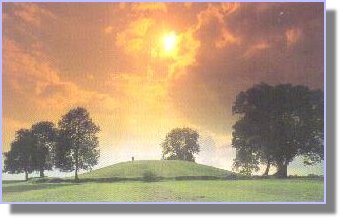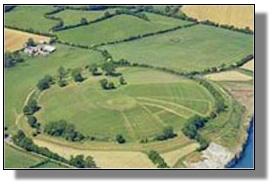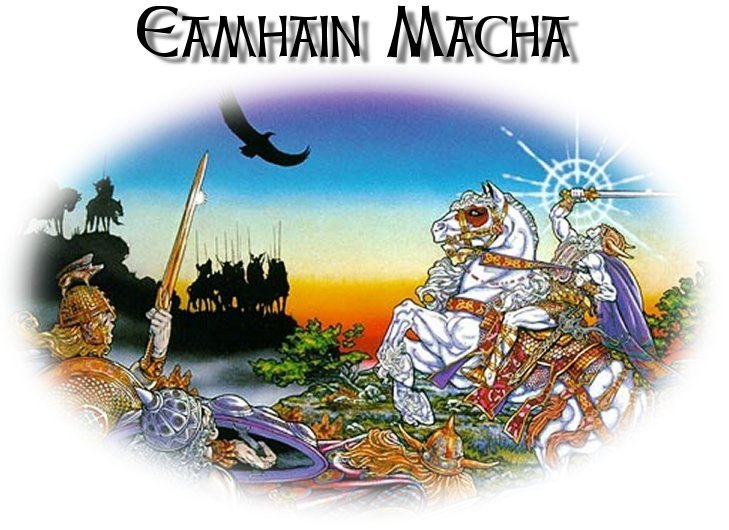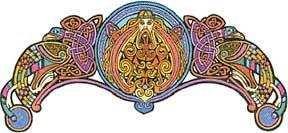 Eamhain Macha, the ancient capital of the kings of Ulster, is situated on the western outskirts of the small city of Armagh. Taking
its name from the goddess Macha, and translated as "Macha's Height", ("Árd Macha") Armagh is
the ecclesiastical capital of both of Ireland's main Christian traditions, and
owes its origins to Saint Patrick, who built a cathedral here in 445 A.D. The
churches, colleges and schools which grew up around this formed the basis of
the modern city. The area surrounding Eamhain Macha is rich in archaeology, and
is often mentioned in the folklore and mythology of Ireland.
Eamhain Macha, the ancient capital of the kings of Ulster, is situated on the western outskirts of the small city of Armagh. Taking
its name from the goddess Macha, and translated as "Macha's Height", ("Árd Macha") Armagh is
the ecclesiastical capital of both of Ireland's main Christian traditions, and
owes its origins to Saint Patrick, who built a cathedral here in 445 A.D. The
churches, colleges and schools which grew up around this formed the basis of
the modern city. The area surrounding Eamhain Macha is rich in archaeology, and
is often mentioned in the folklore and mythology of Ireland.
 No one knows why a circular temple, 43 metres (142 feet) in diameter, was constructed within the perimeter of the mound known as "Eamhain Macha",
around 2,000 years ago.
It seems to have been built quickly,
perhaps by a whole community working together. The roof was held up by concentric rows of posts steadied by horizontal planks and covered with
a cairn of stones enveloped with sods. Then the whole structure was set on fire. Had this been a ritual to invoke the aid of the gods while
Ulster was under attack? Paleoecologists, by matching oak tree growth rings on timbers found here, dated the event at 95 B.C.; it is very likely
that this was a time when Iron Age Celts were attacking late Bronze Age tribes in Ulster.
No one knows why a circular temple, 43 metres (142 feet) in diameter, was constructed within the perimeter of the mound known as "Eamhain Macha",
around 2,000 years ago.
It seems to have been built quickly,
perhaps by a whole community working together. The roof was held up by concentric rows of posts steadied by horizontal planks and covered with
a cairn of stones enveloped with sods. Then the whole structure was set on fire. Had this been a ritual to invoke the aid of the gods while
Ulster was under attack? Paleoecologists, by matching oak tree growth rings on timbers found here, dated the event at 95 B.C.; it is very likely
that this was a time when Iron Age Celts were attacking late Bronze Age tribes in Ulster.
 Close to the west of Eamhain Macha is the townland of Creeveroe, derived from
the Irish Craobh
Ruadh, or "Red Branch". Also nearby are some structures dating from the Bronze
Age. Haughey's
Fort is a hilltop enclosure; the King's Stables are not stables at all, but an
artificial
ritual pool. Just to the north-east lies Loughnashade, a ritual lake
in which many bones and the Loughnashade Trumpet were found. Neolithic Tombs
are to
be found in the hills to the north. The quarry to the east, now disused, was a
source of Navan Limestone, used in the construction of many major buildings in
Armagh.
Close to the west of Eamhain Macha is the townland of Creeveroe, derived from
the Irish Craobh
Ruadh, or "Red Branch". Also nearby are some structures dating from the Bronze
Age. Haughey's
Fort is a hilltop enclosure; the King's Stables are not stables at all, but an
artificial
ritual pool. Just to the north-east lies Loughnashade, a ritual lake
in which many bones and the Loughnashade Trumpet were found. Neolithic Tombs
are to
be found in the hills to the north. The quarry to the east, now disused, was a
source of Navan Limestone, used in the construction of many major buildings in
Armagh.
 Eamhain Macha (known also as "Navan Fort" in its Anglicised form) was
founded by Macha Mong
Ruadh, daughter of Aedh Ruadh (Red Hugh). Her name means "Macha of The Red Tresses", and she
was the seventy-sixth monarch of Ireland. Her father had alternated kingship
with his two brothers, and on his death Macha was elected ruler, but her uncles
objected. In wars she defeated one, Dithorba, killing him, and persuaded the
other, Cimbaeth, to marry her. Macha marked out the extent of the fort here
with her brooch, it is said, and forced the captives from the wars of
succession to build the structure.
Eamhain Macha (known also as "Navan Fort" in its Anglicised form) was
founded by Macha Mong
Ruadh, daughter of Aedh Ruadh (Red Hugh). Her name means "Macha of The Red Tresses", and she
was the seventy-sixth monarch of Ireland. Her father had alternated kingship
with his two brothers, and on his death Macha was elected ruler, but her uncles
objected. In wars she defeated one, Dithorba, killing him, and persuaded the
other, Cimbaeth, to marry her. Macha marked out the extent of the fort here
with her brooch, it is said, and forced the captives from the wars of
succession to build the structure.


 In early historical tales, in literature and mythology, Eamhain Macha is
central to the grouping of stories known as the Ulster Cycle. These are set in
the first century A.D. and largely revolve around the legendary Cúchulainn, a warrior in the
reign of the Ulster king Conor Mac Nessa. Eamhain Macha was occupied from the
third millenium B.C. Its history thus spans between four and five thousand
years. Its most important period was likely to have been during what
archaeologists describe as the Late Bronze/Early Iron age, from around 700
B.C. Macha, who was the seventy-sixth monarch of Ulster lived about 350 B.C.
In early historical tales, in literature and mythology, Eamhain Macha is
central to the grouping of stories known as the Ulster Cycle. These are set in
the first century A.D. and largely revolve around the legendary Cúchulainn, a warrior in the
reign of the Ulster king Conor Mac Nessa. Eamhain Macha was occupied from the
third millenium B.C. Its history thus spans between four and five thousand
years. Its most important period was likely to have been during what
archaeologists describe as the Late Bronze/Early Iron age, from around 700
B.C. Macha, who was the seventy-sixth monarch of Ulster lived about 350 B.C.
 An excavated structure at the fort known as the "temple" is dated as having
been built in 94 B.C. and was burnt down shortly after that. Eamhain
Macha was destroyed in 355 A.D. by soldiers of the High King Muiredeach. These,
Colla Uais, Colla Menn and Colla Dachrigh were known as the "Three Collas" and
were also involved in the destruction of other centres, as well as the
assassination of Eoghaid Mugmedon at the Celtic religious centre at Drumeague,
Co.Cavan.
An excavated structure at the fort known as the "temple" is dated as having
been built in 94 B.C. and was burnt down shortly after that. Eamhain
Macha was destroyed in 355 A.D. by soldiers of the High King Muiredeach. These,
Colla Uais, Colla Menn and Colla Dachrigh were known as the "Three Collas" and
were also involved in the destruction of other centres, as well as the
assassination of Eoghaid Mugmedon at the Celtic religious centre at Drumeague,
Co.Cavan.
 In the second century A.D. the Greek geographer Ptolemy mentioned a place
called Isamnion; this has been identified as having been Eamhain Macha. In the
fifth century Saint Patrick chose Armagh as a centre, bringing the new religion
to the bases of the old, as was the practice in those times. Brian Ború, the king responsible for expelling the Danes from Ireland, is
recorded as having camped here in 1005 A.D., and in 1387 A.D. Niall O'Neill
built a house at Eamhain Macha as a gesture towards the ancient traditions.
In the second century A.D. the Greek geographer Ptolemy mentioned a place
called Isamnion; this has been identified as having been Eamhain Macha. In the
fifth century Saint Patrick chose Armagh as a centre, bringing the new religion
to the bases of the old, as was the practice in those times. Brian Ború, the king responsible for expelling the Danes from Ireland, is
recorded as having camped here in 1005 A.D., and in 1387 A.D. Niall O'Neill
built a house at Eamhain Macha as a gesture towards the ancient traditions.

 Mythology tells of three great halls at Eamhain Macha. The Craobh Ruadh,
meaning "Red Branch", where the king and the warriors lived and feasted,
consisted of nine rooms built of red yew with partitions of bronze, these
clustered round the king's apartment with a ceiling of silver. Bronze pillars
throughout were inlaid with gold. The second hall, the Craobh Deargh (another
way of saying Red Branch), was a treasure house and also the place where the
heads of enemies were displayed. The Tithe Breac, meaning "speckled house", was
a place for storing weapons and armour. Weapons could not be brought into the
main halls due to the dangers of volatile warriors clashing with each other
whilst drunk. There was also a hospital at the fort, and this was known as Brón
Bhearg, meaning "Warriors' Sorrow".
Mythology tells of three great halls at Eamhain Macha. The Craobh Ruadh,
meaning "Red Branch", where the king and the warriors lived and feasted,
consisted of nine rooms built of red yew with partitions of bronze, these
clustered round the king's apartment with a ceiling of silver. Bronze pillars
throughout were inlaid with gold. The second hall, the Craobh Deargh (another
way of saying Red Branch), was a treasure house and also the place where the
heads of enemies were displayed. The Tithe Breac, meaning "speckled house", was
a place for storing weapons and armour. Weapons could not be brought into the
main halls due to the dangers of volatile warriors clashing with each other
whilst drunk. There was also a hospital at the fort, and this was known as Brón
Bhearg, meaning "Warriors' Sorrow".

 "Macha" is a name that appears in different guises and in different times in
Irish mythology. Sometimes she is related as a human woman, marrying named
individuals and giving birth to identifiable people. Her essential origins,
however, lie deeper; Macha is a mystical spiritual entity, one of the three
aspects of the Goddess of war and destruction, the others being Bodb and
Morrigan. As such, Macha was an inspiration to warriors in battle. Heads cut
off in battle were called "Macha's Acorns". One of the chambers at Eamhain
Macha was used as a storehouse for the display of enemies' heads. The religion
of Macha's people was a warrior cult of war and death. Eamhain Macha's origins
have many stories.
"Macha" is a name that appears in different guises and in different times in
Irish mythology. Sometimes she is related as a human woman, marrying named
individuals and giving birth to identifiable people. Her essential origins,
however, lie deeper; Macha is a mystical spiritual entity, one of the three
aspects of the Goddess of war and destruction, the others being Bodb and
Morrigan. As such, Macha was an inspiration to warriors in battle. Heads cut
off in battle were called "Macha's Acorns". One of the chambers at Eamhain
Macha was used as a storehouse for the display of enemies' heads. The religion
of Macha's people was a warrior cult of war and death. Eamhain Macha's origins
have many stories.

 One such tells of a mysterious Macha, arriving in the bed of
one Crunniuc Mac Agnomain, a local Ulster chieftain. She became his wife, and
as such became pregnant by him. One day, whilst racing horses against the king, Crunniuc
boasted that his wife, pregnant as she was, could outrun the king's horses.
Under threat, Macha was forced to take part in a race. At the end of the field
she gave birth to twins. This place was named thereafter as Eamhain Macha, which can be
translated as "Macha's Twins". While Macha gave birth she screamed, and then
said that all who heard this scream would suffer the pangs of childbirth in times
of Ulster's dangers. Only women, young boys and Cúchulainn were to be immune from this
curse. Having said this, Macha died.
One such tells of a mysterious Macha, arriving in the bed of
one Crunniuc Mac Agnomain, a local Ulster chieftain. She became his wife, and
as such became pregnant by him. One day, whilst racing horses against the king, Crunniuc
boasted that his wife, pregnant as she was, could outrun the king's horses.
Under threat, Macha was forced to take part in a race. At the end of the field
she gave birth to twins. This place was named thereafter as Eamhain Macha, which can be
translated as "Macha's Twins". While Macha gave birth she screamed, and then
said that all who heard this scream would suffer the pangs of childbirth in times
of Ulster's dangers. Only women, young boys and Cúchulainn were to be immune from this
curse. Having said this, Macha died.
 The curse, known as the "Cess Noinden
Uladh", has links to the primitive "Couvade", practised by Basques and southern
Europeans until recent times. In this, after childbirth, it is the men who take
to their beds in sickness for a few days. The origins of all this lie in
religions where the female menstrual cycle and the phases of the moon played a
part in religious beliefs. In its mystical origins, Eamhain Macha belongs to
this cultural system, a system which modern man might find difficult to
appreciate.
The curse, known as the "Cess Noinden
Uladh", has links to the primitive "Couvade", practised by Basques and southern
Europeans until recent times. In this, after childbirth, it is the men who take
to their beds in sickness for a few days. The origins of all this lie in
religions where the female menstrual cycle and the phases of the moon played a
part in religious beliefs. In its mystical origins, Eamhain Macha belongs to
this cultural system, a system which modern man might find difficult to
appreciate.

 This is an early Gaelic story telling of Bricriú Memhtheanga, or Bricriú of The
Venomous Tongue. A troublemaker and satirist, Bricriú is said to have built
himself a palace at Dunrory, basing this on that at Eamhain Macha. Bricriú's
name is also associated with Loughbrickland in County Down. His palace finished,
Bricriú invited all of the Red Branch Knights from Eamhain Macha to a great
feast. His purpose was to stir up trouble among them. He did this by offering
the champion's portion to the bravest warrior present. This notion of the
"champions portion", in which the superior warrior would get priority at a
feast, was of great importance to the Ulster warriors. Thus Bricriú, by leaving the
matter open, stirred up rivalry.
This is an early Gaelic story telling of Bricriú Memhtheanga, or Bricriú of The
Venomous Tongue. A troublemaker and satirist, Bricriú is said to have built
himself a palace at Dunrory, basing this on that at Eamhain Macha. Bricriú's
name is also associated with Loughbrickland in County Down. His palace finished,
Bricriú invited all of the Red Branch Knights from Eamhain Macha to a great
feast. His purpose was to stir up trouble among them. He did this by offering
the champion's portion to the bravest warrior present. This notion of the
"champions portion", in which the superior warrior would get priority at a
feast, was of great importance to the Ulster warriors. Thus Bricriú, by leaving the
matter open, stirred up rivalry.
 Similarly at the same feast he stirred up
dissension among the women of Eamhain Macha by encouraging them to compete.
The major warriors present were Loeghaire The Triumphant, Conall Cearnach and
Cúchulainn. A magical character called "The Bachlach" was involved, offering
the warriors the opportunity to cut off his head; he promised to return the next
night and cut off theirs. The warriors decapitated him with their swords; he promptly
replaced it on his shoulders and left. The next night all the warriors except Cúchulainn
failed to appear, wishing to keep their heads a little longer. The Bachlach made a gesture towards Cúchulainn's neck
but, leaving him intact, pronounced him Champion of Ulster.
Similarly at the same feast he stirred up
dissension among the women of Eamhain Macha by encouraging them to compete.
The major warriors present were Loeghaire The Triumphant, Conall Cearnach and
Cúchulainn. A magical character called "The Bachlach" was involved, offering
the warriors the opportunity to cut off his head; he promised to return the next
night and cut off theirs. The warriors decapitated him with their swords; he promptly
replaced it on his shoulders and left. The next night all the warriors except Cúchulainn
failed to appear, wishing to keep their heads a little longer. The Bachlach made a gesture towards Cúchulainn's neck
but, leaving him intact, pronounced him Champion of Ulster.

![]()



![]()